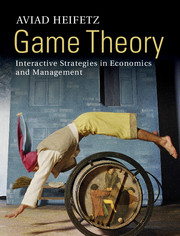Book contents
- Frontmatter
- Contents
- Foreword
- Part I Strategic interactions as games
- Part II Basic solution concepts for strategic form games
- Part III Prominent classes of strategic form games
- 7 Cooperation and conflict, strategic complements and substitutes
- 8 Concentrated markets
- 9 Coordination games and strategic uncertainty
- Part IV Uncertainty and mixed strategies
- Part V Advanced topics in strategic form games
- Part VI Dynamic games
- Part VII Repeated games
- Index
- References
7 - Cooperation and conflict, strategic complements and substitutes
from Part III - Prominent classes of strategic form games
Published online by Cambridge University Press: 05 August 2012
- Frontmatter
- Contents
- Foreword
- Part I Strategic interactions as games
- Part II Basic solution concepts for strategic form games
- Part III Prominent classes of strategic form games
- 7 Cooperation and conflict, strategic complements and substitutes
- 8 Concentrated markets
- 9 Coordination games and strategic uncertainty
- Part IV Uncertainty and mixed strategies
- Part V Advanced topics in strategic form games
- Part VI Dynamic games
- Part VII Repeated games
- Index
- References
Summary
In the preceding chapters, we described a variety of games possessing various attributes, yet some of those games resembled one another in various ways. In Chapters 1 and 2 we described three different games of the “social dilemma” type, and we explained in what sense the three games are equivalent. More generally, finding common attributes for various games will enable us to catalog the games into categories, and to identify the forces and tensions that affect the equilibrium in a given category of games.
In this chapter, we take our first step in this cataloging process, by identifying two game attributes. The first attribute for differentiating between games is natural and simple. This attribute will answer the question: is the strategic interaction between the players one of cooperation or of conflict? We say that the strategic interaction is one of cooperation if every player always prefers that the other player or players intensify their actions. We will say that the strategic interaction is one of conflict if every player always prefers that the other player or players moderate their actions. The distinction between games of cooperation and games of conflict is accordingly relevant when the strategies of each player are completely ordered by their intensity or strength, from the most moderate to the most intensive strategy. An order relation of this kind is, in fact, definable in each of the examples we have encountered so far.
The second attribute we will present in this chapter, for the purpose of distinguishing between games, is more complex. It, too, is applicable only in games in which the strategies of each player can be ordered by their intensity. It will answer the question: will the player wish to intensify her actions when the other players intensify their actions? If every player will wish to intensify her action in response to the intensification of the activity of the other players or of at least some of them, we say that the game is one of strategic complements. If every player will wish to moderate her action in response to the intensification of the activity of the other players or of at least some of them, we say that the game is one of strategic substitutes.
- Type
- Chapter
- Information
- Game TheoryInteractive Strategies in Economics and Management, pp. 89 - 117Publisher: Cambridge University PressPrint publication year: 2012



